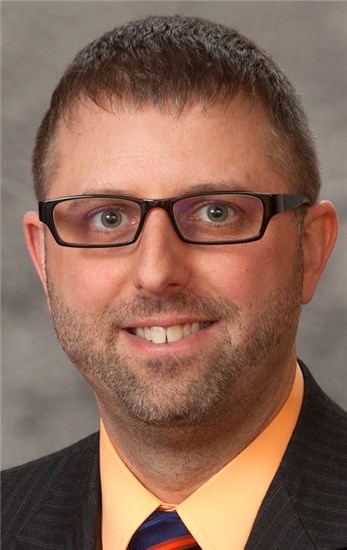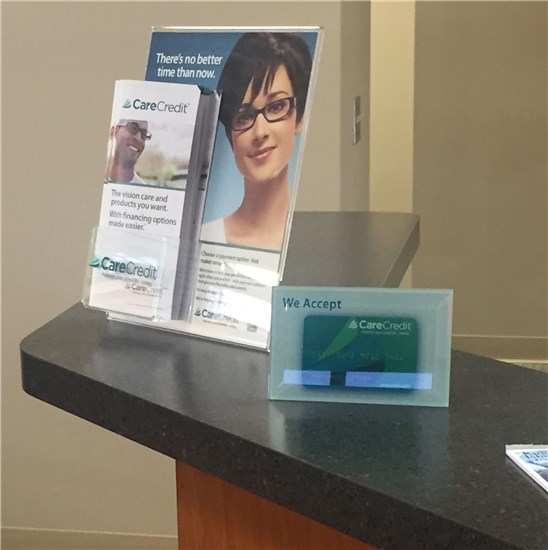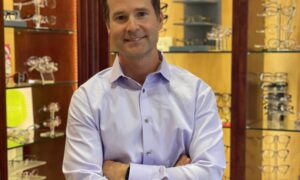By Dave Anderson, OD
July 22, 2015
SYNOPSIS
Your professional voice carries weight when you prescribe eyewear from the exam room. When you mention the availability of patient financing, more patients fulfill your treatment plan.
ACTION POINTS
PRESCRIBE, DON’T RECOMMEND. Use the words “prescribe,” rather than “recommend,” so patients understand products are part of their treatment plan.
TALK PATIENT FINANCING IN EXAM ROOM. OD should mention patient financing as a way to purchase prescribed products and services.
DISCUSS ALL OPTIONS. Don’t pre-judge patient’s finances. Discuss all options, including refractive surgery, CLs & multiple pairs of eyewear.
When I prescribe patients eyewear, contact lenses, or another product or service, I do so from the exam room, while they are still in my chair. I find that the authority of the doctor carefully explaining why the products and services I have prescribed are necessary is essential to patients following through. One of the ways I make it easier for patients to follow my prescriptions is the patient financing we offer patients who have the CareCredit credit card. My practice has introduced CareCredit to our patients for the last year, and we have 15-20 new CareCredit cardholders per month. Patients appreciate having another way to help them budget for their eyewear and eye health needs.
In our one-location practice, which has three ODs and16-support-staff, we have seen a near 10 percent growth in sales of both contact lenses and glasses over the last 10 years, adding up to annual revenues of $2.2 million. We have also noticed that CareCredit cardholders, on average, spend over $300 during their office visit. We’re not sure exactly how much of that spending is due to the flexibility of payment provided by patient financing, but we do believe it may be a factor. We have a highly trained staff that understands how to best help patients with their vision needs. Our staff are always willing to try new lens options, new lens designs and anything that could potentially help a patient see better or feel better with their glasses or contacts. Ultimately, it’s always about listening to a patients needs, and answering them with the products that can best help them.
Dr. Anderson’s practice web site shows patients some of the products available in his office, along with the patient option to use CareCredit to pay for purchases and services. The CareCredit box, along with the boxes advertising products the practice sells, is visible on the bottom of every page of the practice web site, reinforcing the patient financing message to patients.
Prescribe, Don’t Recommend
Chair-side doctor prescribing has less to do with the actual prescription than it does with the patient’s vision concerns. During the course of the exam, many things are discussed, including a patient’s work environment, hobbies and vision challenges.
Patients readily tell me about night driving issues, glare problems and strain at their computer. When determining their glasses Rx, I always go back to the troubles they came in with and prescribe something to fix those issues. I recommend computer glasses, non-glare treatments, Transitions and high-index materials just in the same way I describe the change in their glasses Rx. I talk about the “options” as solutions to fix their problems.
I say: “I am prescribing a computer progressive lens– much like your regular no-line lenses–but with the power set for your work station. These lenses will be a thin and light material to keep you comfortable during the day, with non-glare to decrease your eyestrain and computer fatigue.” I have experimented with writing the Rx with all the recommendations vs. just a frank and honest conversation, and for most patients, a discussion is enough to get them to understand the lens options and features that will help provide the best vision and solve their problems.
Patient financing is one of the ways I am able to help patients stay focused on their vision eye health needs, rather than cost concerns. I never worry about the financials when chair-side prescribing. If I did, I would not speak to their needs, only to their cost concerns. I always mention that I’m a consumer myself and know there are many options for where patients can purchase products. I tell them that our staff is always helpful when there are cost concerns, and that we have options like patient financing available to help them accomplish all of their vision goals.
Mention Patient Financing in Exam Room
I mention CareCredit when a patient has multiple needs for their vision. Discussing CareCredit with patients in the exam room is especially helpful when patients have both contacts and glasses needs. CareCredit can also make it possible for patients to get all of their vision needs taken care of when there is a need for both regular prescription glasses, along with either prescription or plano sunglasses.
When discussing financing options, make sure the patient’s ability to fully understand and process this information is not impaired in any way (e.g. by anesthesia, medication or discomfort). Many practices have a set process as to when they introduce CareCredit to their patients. You want to make sure they fully understand the suggested treatment, the cost associated with the treatment, and what payment options they have.
Move Beyond the Lifestyle Questionnaire
We have a lifestyle questionnaire, but many patients either come in with a certain mindset, or just a list of problems in their head, and want answers. The natural solution in their mind is usually just a change in prescription. I need to explain to patients that the solution often lies in the materials the glasses or contacts can be made of, and the different ways they can be made to be more effective, such as good quality materials, properly fitting lenses and lenses created with the patient’s needs in mind.
Discuss All Options
Most of the time patients have an idea that they only want eyewear and services that are covered by their insurance. I always use analogies, comparing things like cars, phones and computers to the products we sell. I always offer new ideas, from a multifocal contact lens to custom progressive glasses. I always discuss daily disposable contacts, and all the other contact lens and eyewear options. I often bring up refractive surgical options, as well. My philosophy is to discuss all options that could help a patient, and guide them in the direction that is best for their vision needs.
It usually only takes 1-2 extra minutes to discuss my prescriptions with the patient. This does more than just impact the visit that day; I also use this conversation to plant seeds for future vision changes. If someone is nearing presbyopia, or has some mild dryness with their contacts, regardless of my recommendation, I let them know about things I will do in the future to help them see. This may be something as simple as discussing their hobbies, and the potential for wearing contacts. I want patients to know that I can help with any vision need they have, so they won’t ever feel as if I’m not there to help them.
Doctor Should Introduce Patient to Optician
We originally used scribes to carry my prescription from exam room to optical, but this didn’t have the same weight as when I introduce the patient to the optician. I go over what the patient needs, but I also touch on the visual complaints and vision demands that were discussed in the exam room. Our optician feels this helps move any patient who is on the fence about an eyewear option that is in their best interest, but which they may not fully understand. When I pass the message on in the optical as the doctor, it is conveyed as a prescription, rather than the up-sale of a product.
Opticians Should Mention Patient Financing
We don’t use a specific staff script about patient financing, but we have instructed staff to educate patients about the option of using CareCredit to make their purchase.
Offer Patient Financing & Promotions
Our office offers second-pair discounts and CareCredit as a way to allow our patients to get what they need, rather than just what is covered by their insurance. I talk about insurance coverage in a few ways to help with the “I want what’s covered mentality.” I compare insurance coverage to a gift card. If someone has a gift card for a shoe store, they wouldn’t just look at the shoes that are “covered”; they would find one that fits, is comfortable and would stand up to day-to-day use. The same goes for glasses or contacts–it is best to find what you need, and then defray some of the cost with your insurance, second-pair discounts and CareCredit. Glasses and contacts are usually worn every day, so they need to work well.
Discuss Specific Lens Treatments
Every day, I talk about the value of AR and Transitions. In our office, we have a 65 percent AR and 25 percent Transitions sales rate. We have seen increases in this area over the 10 years that I have been in this office, but it is a slow and gradual change. When I started, we were never above 35 percent, partly due to an older patient base, but in part due to new patients having bad experiences with sub-par products at some retail chains close to our office.
To prove the difference that the doctor’s prescription of lens treatments in the exam room makes, I conducted a one-month experiment a few years ago: Without telling my optical staff about this experiment, I left it up to my optical staff alone to discuss lens treatments. I knew the numbers would decrease, but I was shocked at how much they decreased. Before I stopped talking about lens treatments in the exam room, my AR percent was hovering around 40 percent, and during the month that I did not mention it at all, my AR percent dropped to 18 percent. This amounted to several thousand dollars of loss, and over the course of a year, would potentially run our office out of business.
Use Lens Demos in Optical & Let Patients Try CLs
We use lens demos, as some patients are hands-on, visual learners. We have dispensing mats that demonstrate the various options, from AR to a progressive lens design. The biggest thing is that each patient has a certain level of knowledge they are interested in, and tailoring the message to that level helps them become educated about their lenses and the new options that could help them see better.
Many times I put contacts on a patient’s eyes for them to test the idea of wearing them, or for a very high prescription, to see their glasses while selecting a new frame. I explain that putting contacts on the eye, and truly fitting a contact lens is different, and patients are receptive to the idea. They also like the idea that I am doing something to truly give them the best visual experience and allow them to make a great decision for their glasses, while at the same time giving them a taste of vision with contact lenses.
In our office, we have seen a near 10 percent growth in sales of both contact lenses and glasses over the last 10 years. We have a highly trained staff that understands how to best help patients with their vision needs. Our staff are always willing to try new lens options, new lens designs and anything that could potentially help a patient see better or feel better with their glasses or contacts. Ultimately, it’s always about listening to a patients needs, and answering them with the products that can best help them.
Dave Anderson, OD, is a partner withMiamisburg Vision Care in Miamisburg, Ohio. To contact: doca@burgvision.com



























